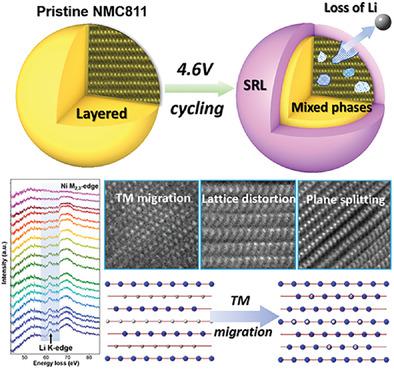Our official English website, www.x-mol.net, welcomes your
feedback! (Note: you will need to create a separate account there.)
High-Voltage Induced Surface and Intragranular Structural Evolution of Ni-Rich Layered Cathode
Small ( IF 13.0 ) Pub Date : 2022-04-11 , DOI: 10.1002/smll.202200627
Hanshuo Liu 1 , Zhong Xie 1 , Wei Qu 1 , Eben Dy 1 , Svetlana Niketic 1 , Shawn Brueckner 1 , Ken Tsay 1 , Eric Fuller 1 , Christina Bock 1 , Nafiseh Zaker 2 , Gianluigi A Botton 2
Small ( IF 13.0 ) Pub Date : 2022-04-11 , DOI: 10.1002/smll.202200627
Hanshuo Liu 1 , Zhong Xie 1 , Wei Qu 1 , Eben Dy 1 , Svetlana Niketic 1 , Shawn Brueckner 1 , Ken Tsay 1 , Eric Fuller 1 , Christina Bock 1 , Nafiseh Zaker 2 , Gianluigi A Botton 2
Affiliation

|
Layered Ni-rich lithium transition metal oxides are promising cathode materials for high-energy-density lithium-ion batteries. These cathodes, however, suffer from rapid performance decay under high-voltage operation. In this work, the electrochemical properties and structural evolution of the LiNi0.8Mn0.1Co0.1O2 (NMC811) cathode upon high-voltage cycling are investigated. The results show that the NMC811 cathode not only experiences surface evolution with the formation of Li-deficient rock-salt layers, but also suffers from drastic intragranular structural changes inside bulk grains after high-voltage cycling. Direct evidence for the formation of transition-metal/Li disordering domains with uneven Li content and lattice plane distortion at the internal grains of 4.6 V-cycled NMC811 are provided with their atomic ordering and spatial distribution clearly resolved. The complex intragranular structural changes impede Li+ diffusion inside bulk material, resulting in kinetic limitation and capacity loss. The results demonstrate that the high-voltage cycling would induce severe structural degradation at the grain interior of the cathode material beyond surface evolution, which contributes significantly to the rapid performance decay of the NMC811 cathode. The findings provide new insights for developing effective countermeasures to mitigate this degradation pathway.
中文翻译:

富镍层状阴极的高压诱导表面和晶内结构演化
层状富镍锂过渡金属氧化物是用于高能量密度锂离子电池的有前途的正极材料。然而,这些阴极在高压操作下会遭受快速的性能衰减。在这项工作中,LiNi 0.8 Mn 0.1 Co 0.1 O 2的电化学性能和结构演变(NMC811)阴极在高压循环下进行了研究。结果表明,NMC811正极不仅经历了表面演化,形成了缺锂岩盐层,而且在高压循环后,块状晶粒内部也发生了剧烈的晶内结构变化。提供了在 4.6 V 循环 NMC811 的内部晶粒处形成具有不均匀 Li 含量和晶格平面畸变的过渡金属/Li 无序域的直接证据,它们的原子排序和空间分布清晰地得到了解决。复杂的晶内结构变化阻碍了 Li +散装材料内部的扩散,导致动力学限制和容量损失。结果表明,高压循环会在正极材料的晶粒内部引起严重的结构退化,而不是表面演化,这对 NMC811 正极的快速性能衰减有重要影响。这些发现为开发有效的对策以减轻这种降解途径提供了新的见解。
更新日期:2022-04-11
中文翻译:

富镍层状阴极的高压诱导表面和晶内结构演化
层状富镍锂过渡金属氧化物是用于高能量密度锂离子电池的有前途的正极材料。然而,这些阴极在高压操作下会遭受快速的性能衰减。在这项工作中,LiNi 0.8 Mn 0.1 Co 0.1 O 2的电化学性能和结构演变(NMC811)阴极在高压循环下进行了研究。结果表明,NMC811正极不仅经历了表面演化,形成了缺锂岩盐层,而且在高压循环后,块状晶粒内部也发生了剧烈的晶内结构变化。提供了在 4.6 V 循环 NMC811 的内部晶粒处形成具有不均匀 Li 含量和晶格平面畸变的过渡金属/Li 无序域的直接证据,它们的原子排序和空间分布清晰地得到了解决。复杂的晶内结构变化阻碍了 Li +散装材料内部的扩散,导致动力学限制和容量损失。结果表明,高压循环会在正极材料的晶粒内部引起严重的结构退化,而不是表面演化,这对 NMC811 正极的快速性能衰减有重要影响。这些发现为开发有效的对策以减轻这种降解途径提供了新的见解。































 京公网安备 11010802027423号
京公网安备 11010802027423号